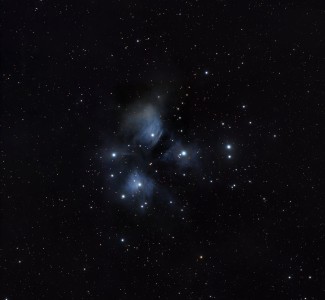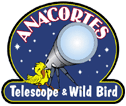Astronomik Narrowband Filters

[ARTICLEIMGR="1"]Astronomik Narrowband Filters
Astronomik filters have been around for about two years in the USA. I was curious as to their performance compared to the standard Lumicon filters. Astronomik claims their filter glass is flat to 1/4 wave and does not disturb the view in the eyepiece.
I started with the 2 inch UHC filter of theirs. All testing was done with a 16 inch Starmaster from a dark site using a filter slide so changes were quick and comparisons could be repeated as needed. The Lumicon filter I compared was an average specimen with transmissions in the high 80's and low 90's for it's passbands. Starting with the Orion Nebula and the Lumicon filter at 77x (27mm Panoptic), the view was it's usual wonderful self. A quick push on the filter slide to select the Astronomik and WOW, the level of detail went up about the equivalent of one aperture size! What was producing this effect appeared to be a much greater contrast in the features of the nebula. There was a tremendous amount of detail readily apparent that was not there at first look in the Lumicon. Stars were nice and tight, details were very sharp and contrasty. Going back to the Lumicon and looking for the missing details now that I knew where to look did produce them although nowhere near as crisp and easily apparent as the Astronomik filter. Moving to the Rosette Nebula produced the same effects. The view through the Astronomik UHC had much more contrast features with nice tight stars. The view through the Lumicon required working hard to see near the same level of detail and was less contrasty.
Next up was the Hb filter. The target of choice for this was the Horsehead in Orion. This time I compared a premium Lumicon with 97% transmission to the Astronomik. The view through the Astronomik was breathtaking. At 122x (17mm Nagler) the dark notch of the horsehead was alive with fine details and the faint wisp on the back of the neck was just visible. Going to the Lumicon, the wisp disappeared along with some of the finer details. Given this was a superb night, I was blown away by what could be seen of the horsehead with the Astronomik Hb and 16" scope. The faint arcs that make the head and nose were very plainly visible, and the field was alive with fine details that "run of the mill". seeing obscures.
Moving on was the O-3 filter. Sampled were a mid 90's transmission Lumicon and the Astronomik O-3 filter. Once again the Astronomik came through with more in contrast features and fine detail. The Lumicon was good, but the Astronomik surpassed it by quite a margin. The view was an improvement of almost the difference aperture makes going from 16" to 20". It didn't quite make it to the 20" level, but it did surpass the view in an 18" using the Lumicon. If there is one thing I love, it is weightless aperture gain and I feel the Astronomik filters deliver here! Examining the Medusa Nebula in Gemini with the Astronomik showed a wealth of fine details and contrast patches. The Lumicon couldn't match the view once again. Once the Veil in Cyngus came around again, the same results were seen there too.
From a mechanical point of view, the filters come in a nice plastic case, are well made, have a 5 year warranty and both the 2" (48mm) and 1.25" have threaded onto both Meade and Televue eyepieces I have used. I guess the telling statement from my point of view is I now own the 2" and 1.25" Astronomik filters exclusively. Nothing else I have tried comes even close. They hold up excellent in low power views and I have used them up to 500x on small planetaries with the same excellent results. Your mileage may vary, but Astronomik filters have a loyal customer with me!
David Paessler
16" Starmaster
Astronomik filters have been around for about two years in the USA. I was curious as to their performance compared to the standard Lumicon filters. Astronomik claims their filter glass is flat to 1/4 wave and does not disturb the view in the eyepiece.
I started with the 2 inch UHC filter of theirs. All testing was done with a 16 inch Starmaster from a dark site using a filter slide so changes were quick and comparisons could be repeated as needed. The Lumicon filter I compared was an average specimen with transmissions in the high 80's and low 90's for it's passbands. Starting with the Orion Nebula and the Lumicon filter at 77x (27mm Panoptic), the view was it's usual wonderful self. A quick push on the filter slide to select the Astronomik and WOW, the level of detail went up about the equivalent of one aperture size! What was producing this effect appeared to be a much greater contrast in the features of the nebula. There was a tremendous amount of detail readily apparent that was not there at first look in the Lumicon. Stars were nice and tight, details were very sharp and contrasty. Going back to the Lumicon and looking for the missing details now that I knew where to look did produce them although nowhere near as crisp and easily apparent as the Astronomik filter. Moving to the Rosette Nebula produced the same effects. The view through the Astronomik UHC had much more contrast features with nice tight stars. The view through the Lumicon required working hard to see near the same level of detail and was less contrasty.
Next up was the Hb filter. The target of choice for this was the Horsehead in Orion. This time I compared a premium Lumicon with 97% transmission to the Astronomik. The view through the Astronomik was breathtaking. At 122x (17mm Nagler) the dark notch of the horsehead was alive with fine details and the faint wisp on the back of the neck was just visible. Going to the Lumicon, the wisp disappeared along with some of the finer details. Given this was a superb night, I was blown away by what could be seen of the horsehead with the Astronomik Hb and 16" scope. The faint arcs that make the head and nose were very plainly visible, and the field was alive with fine details that "run of the mill". seeing obscures.
Moving on was the O-3 filter. Sampled were a mid 90's transmission Lumicon and the Astronomik O-3 filter. Once again the Astronomik came through with more in contrast features and fine detail. The Lumicon was good, but the Astronomik surpassed it by quite a margin. The view was an improvement of almost the difference aperture makes going from 16" to 20". It didn't quite make it to the 20" level, but it did surpass the view in an 18" using the Lumicon. If there is one thing I love, it is weightless aperture gain and I feel the Astronomik filters deliver here! Examining the Medusa Nebula in Gemini with the Astronomik showed a wealth of fine details and contrast patches. The Lumicon couldn't match the view once again. Once the Veil in Cyngus came around again, the same results were seen there too.
From a mechanical point of view, the filters come in a nice plastic case, are well made, have a 5 year warranty and both the 2" (48mm) and 1.25" have threaded onto both Meade and Televue eyepieces I have used. I guess the telling statement from my point of view is I now own the 2" and 1.25" Astronomik filters exclusively. Nothing else I have tried comes even close. They hold up excellent in low power views and I have used them up to 500x on small planetaries with the same excellent results. Your mileage may vary, but Astronomik filters have a loyal customer with me!
David Paessler
16" Starmaster


